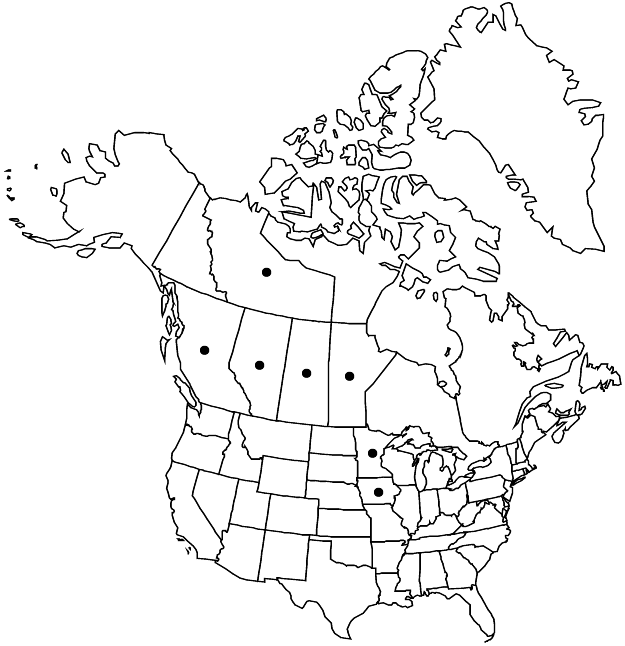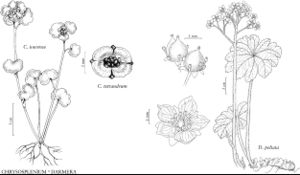Difference between revisions of "Chrysosplenium iowense"
in N. L. Britton, Man. Fl. N. States, 483. 1901 (as iowensis) ,.
FNA>Volume Importer |
imported>Volume Importer |
||
| (6 intermediate revisions by 2 users not shown) | |||
| Line 1: | Line 1: | ||
{{Treatment/ID | {{Treatment/ID | ||
|accepted_name=Chrysosplenium iowense | |accepted_name=Chrysosplenium iowense | ||
| − | |accepted_authority=Rydberg | + | |accepted_authority=Rydberg |
|publications={{Treatment/Publication | |publications={{Treatment/Publication | ||
|title=in N. L. Britton, Man. Fl. N. States, | |title=in N. L. Britton, Man. Fl. N. States, | ||
| Line 7: | Line 7: | ||
}} | }} | ||
|common_names=Iowa golden-saxifrage | |common_names=Iowa golden-saxifrage | ||
| + | |special_status={{Treatment/ID/Special_status | ||
| + | |code=F | ||
| + | |label=Illustrated | ||
| + | }}{{Treatment/ID/Special_status | ||
| + | |code=E | ||
| + | |label=Endemic | ||
| + | }} | ||
|basionyms= | |basionyms= | ||
|synonyms={{Treatment/ID/Synonym | |synonyms={{Treatment/ID/Synonym | ||
|name=Chrysosplenium alternifolium var. iowense | |name=Chrysosplenium alternifolium var. iowense | ||
|authority=(Rydberg) B. Boivin | |authority=(Rydberg) B. Boivin | ||
| + | |rank=variety | ||
}} | }} | ||
|hierarchy=Saxifragaceae;Chrysosplenium;Chrysosplenium iowense | |hierarchy=Saxifragaceae;Chrysosplenium;Chrysosplenium iowense | ||
| Line 25: | Line 33: | ||
|habitat=Marshes, bogs, wet meadows, stream banks, moist seeps, algific talus slopes, 500-1500 m | |habitat=Marshes, bogs, wet meadows, stream banks, moist seeps, algific talus slopes, 500-1500 m | ||
|distribution=Alta.;B.C.;Man.;N.W.T.;Sask.;Iowa;Minn. | |distribution=Alta.;B.C.;Man.;N.W.T.;Sask.;Iowa;Minn. | ||
| − | |discussion=<p>Iowa populations of Chrysosplenium iowense are widely disjunct from Canadian populations. The former are thought to represent Pleistocene relicts, isolated in the Driftless Area of northeastern Iowa and southeastern Minnesota. R. M. Weber (1979) studied the reproductive biology and ecology of the species in northeastern Iowa.</p><!-- | + | |discussion=<p>Iowa populations of <i>Chrysosplenium iowense</i> are widely disjunct from Canadian populations. The former are thought to represent Pleistocene relicts, isolated in the Driftless Area of northeastern Iowa and southeastern Minnesota. R. M. Weber (1979) studied the reproductive biology and ecology of the species in northeastern Iowa.</p><!-- |
| − | --><p>H. Hara (1957) treated Chrysosplenium iowense as synonymous with C. alternifolium Linnaeus var. sibiricum H. Hara. J. G. Packer (1963) recognized the close similarity between C. iowense and C. alternifolium var. sibiricum but maintained the two as distinct species in the absence of a modern, detailed analysis of the C. alternifolium complex. That approach is adopted here.</p> | + | --><p>H. Hara (1957) treated <i>Chrysosplenium iowense</i> as synonymous with C. alternifolium Linnaeus var. sibiricum H. Hara. J. G. Packer (1963) recognized the close similarity between <i>C. iowense</i> and C. alternifolium var. sibiricum but maintained the two as distinct species in the absence of a modern, detailed analysis of the C. alternifolium complex. That approach is adopted here.</p> |
|tables= | |tables= | ||
|references={{Treatment/Reference | |references={{Treatment/Reference | ||
| Line 38: | Line 46: | ||
-->{{#Taxon: | -->{{#Taxon: | ||
name=Chrysosplenium iowense | name=Chrysosplenium iowense | ||
| − | + | |authority=Rydberg | |
| − | |authority=Rydberg | ||
|rank=species | |rank=species | ||
|parent rank=genus | |parent rank=genus | ||
| Line 51: | Line 58: | ||
|publication title=in N. L. Britton, Man. Fl. N. States, | |publication title=in N. L. Britton, Man. Fl. N. States, | ||
|publication year= | |publication year= | ||
| − | |special status= | + | |special status=Illustrated;Endemic |
| − | |source xml=https:// | + | |source xml=https://bitbucket.org/aafc-mbb/fna-data-curation/src/2e0870ddd59836b60bcf96646a41e87ea5a5943a/coarse_grained_fna_xml/V8/V8_142.xml |
|genus=Chrysosplenium | |genus=Chrysosplenium | ||
|species=Chrysosplenium iowense | |species=Chrysosplenium iowense | ||
Latest revision as of 22:41, 5 November 2020
Stolons white, 0.3–1.2 mm diam., sparsely villous, hairs white or reddish brown. Flowering stems erect, branching in distal 1/6–1/3, 3–15 cm, glabrous. Leaves alternate, membranous. Stolon leaves: petiole 7–43 mm, sparsely villous, hairs white or reddish brown; blade depressed-ovate to reniform, 6–13 × 7–18 mm, base cordate, margins 5–9-crenate, not purple-spotted, glabrous or sparsely ciliate, hairs white, surfaces glabrous or sparsely villous, especially near petiole, hairs usually white, sometimes purplish. Cauline leaves 1–3; petiole 3–23(–26) mm, glabrous or villous proximally, hairs purplish; blade depressed-ovate to reniform or flabellate, 6–17 × 9–23 mm, base cordate or, rarely, cuneate, margins 5–9-crenate, glabrous, surfaces glabrous abaxially and adaxially or, rarely, villous near petiole, hairs purplish. Inflorescences terminal, 3–12-flowered, compact cymes; bracts greenish yellow, not purple-spotted, foliaceous, ovate to depressed-ovate or flabellate, 2–10 × 2–11 mm, margins 3–7-crenate. Pedicels absent or 0.1–1.2 mm. Flowers: hypanthium yellow or greenish yellow, not purple-spotted, campanulate, 1.2–2.3 × 1.5–3 mm, glabrous; sepals spreading, yellow or greenish yellow, not purple-spotted, ovate to broadly ovate, 0.9–1.5 × 1.1–2 mm, apex obtuse to rounded; nectary disc inconspicuous, yellow, unlobed; stamens 2–8, 0.6–0.7 mm; anthers yellow, 0.1–0.2 × 0.1–0.2 mm; styles 0.3–0.4 mm. Seeds (8–)20–30(–56), reddish brown, ovoid to ellipsoid, (0.5–)0.6–0.9 mm, glabrous. 2n = ca. 120.
Phenology: Flowering May–Jun.
Habitat: Marshes, bogs, wet meadows, stream banks, moist seeps, algific talus slopes, 500-1500 m
Distribution

Alta., B.C., Man., N.W.T., Sask., Iowa, Minn.
Discussion
Iowa populations of Chrysosplenium iowense are widely disjunct from Canadian populations. The former are thought to represent Pleistocene relicts, isolated in the Driftless Area of northeastern Iowa and southeastern Minnesota. R. M. Weber (1979) studied the reproductive biology and ecology of the species in northeastern Iowa.
H. Hara (1957) treated Chrysosplenium iowense as synonymous with C. alternifolium Linnaeus var. sibiricum H. Hara. J. G. Packer (1963) recognized the close similarity between C. iowense and C. alternifolium var. sibiricum but maintained the two as distinct species in the absence of a modern, detailed analysis of the C. alternifolium complex. That approach is adopted here.
